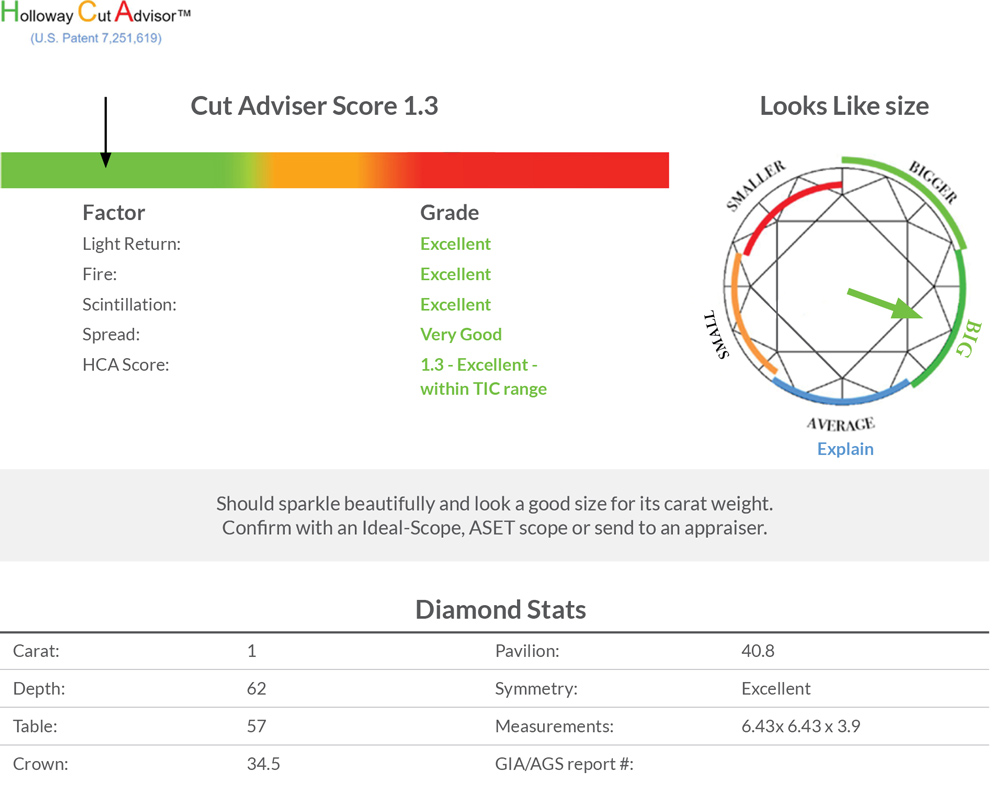No products in the cart.
Learn: Diamond Grading > Holloway Cut Adviser
Why do we reject 90% of GIA’s top cut quality round diamonds?
90% of GIA’s top cut grade Excellent diamonds are cut to weigh more in carats and not necessarily cut for the best sparkle and reflection from the stone.
This is where the Holloway Cut Adviser (HCA) tool plays an important step in rejecting those diamonds that have high light leakage and will always look dull (even though they have a XXX GIA cut grade).
Everyone wants their diamond to look bigger and sparklier!
Holloway Cut Adviser (HCA) rates a diamond’s cut in lay terms for its light return, fire, scintillation and spread (how big the diamond is for its weight). A diamond with an HCA grade of excellent is rare and means this diamond is good for further consideration.
Having passed HCA the diamond has potential and is then assessed with an Ideal-Scope, checked for transparency and other Holloway diamond™ proprietary tests.
HCA is used by trade and consumer buyers and sellers to assess the cut quality of over $2 billion dollars worth of diamonds a year.
HCA will help you to quickly reject poorly cut diamonds.
What about the GIA Report?
You must read this! You need to start your research by understanding the diamond quality based on Carat Weight, Cut, Clarity, and Colour. The GIA report will provide you with an excellent guide on Carat Weight, Clarity and Colour.
But to get a real sparkler! … start the rejecting process with the HCA tool.
Holloway Cut Adviser (HCA)
Holloway Cut Adviser (HCA) is an online cut grading system developed in 2000 which was patented, by our founder, Garry Holloway, in 2001. U.S. Patent 7,251,619 The Gemmological Institute of America (GIA) developed its cut grading system on the same basis which it began using in 2006.
What will HCA NOT do?
HCA uses table size, crown, and pavilion angles and depth but does not factor in, polish, or minor facets. Therefore it is a rejection tool and should be used in conjunction with expert analysis. HCA works best when combined with an Ideal-Scope analysis.
When you assess your round diamond with HCA, you’re after a score below 2 (Excellent) This means you have eliminated known poorly cut diamonds
(NOTE: This accounts for more than 95% of all round diamonds and at least 80% of GIA XXX). In fact, most GIA Excellent cut diamonds score in the HCA range of 3 to 6! a lower score is not the aim; for rings, many people prefer diamonds with an HCA score between 1.0 and 2.0.
A shallower stone, on the lower part of the chart, will look darker when viewed from close up, they are not for everyone.
TIP 1
Shallow-cut diamonds usually score below 1.0 and these work best for earrings and pendants because they will look darker when viewed from close up (a close observer’s head obstructs light sources that would otherwise be returned), they are not for everyone. They have the advantage of a bigger spread as well and do not show dirt as much as classic and generally most favoured proportion diamonds. This is a good thing because we know that earrings are often the dirtiest diamond we ever see. They are better suited for use as pendants and earring stones where they are not usually viewed from very close proximity.

A more recent development is the addition to HCA of Looks Like (the graphic on the right side of HCA results). This was granted a US patent 10,739,271B2 in 2020 and compares the optimum to the actual diamond’s dimensions and quantifies the diamond’s peripheral leakage. Leakage near the edge of the diamond will make the diamond appear smaller. This is a very useful tool to make sure you are getting diamond value for your dollars!
CHECK YOUR DIAMOND BEFORE YOU BUY
If you’re considering round diamonds from another supplier use the link below to check its cut score. You will need the details from a GIA report to complete this process.
For more information or assistance simply speak with a Holloway Diamonds specialist who will explain the HCA process and also our Holloway diamond™ policy.
